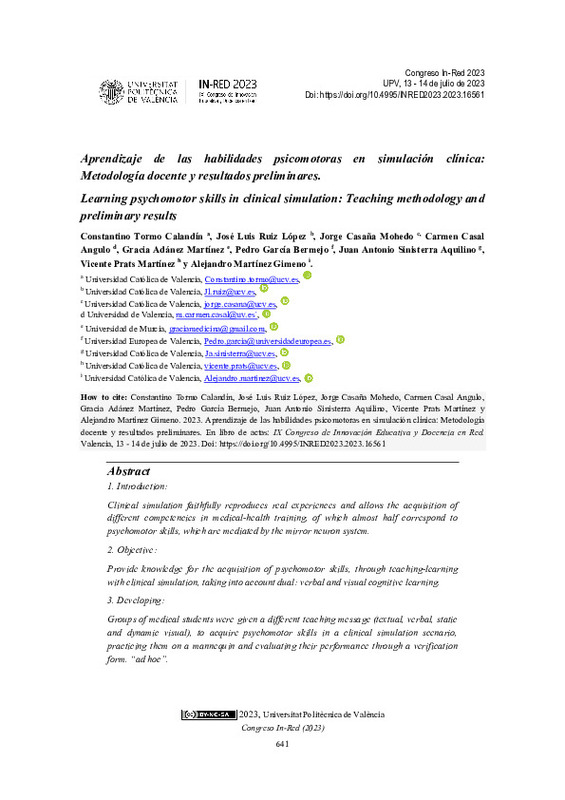JavaScript is disabled for your browser. Some features of this site may not work without it.
Buscar en RiuNet
Listar
Mi cuenta
Estadísticas
Ayuda RiuNet
Admin. UPV
Aprendizaje de las habilidades psicomotoras en simulación clínica: Metodología docente y resultados preliminares
Mostrar el registro sencillo del ítem
Ficheros en el ítem
| dc.contributor.author | Tormo-Calandín, Constantino
|
es_ES |
| dc.contributor.author | Ruiz López, José
|
es_ES |
| dc.contributor.author | Casaña Mohedo, Jorge
|
es_ES |
| dc.contributor.author | Casal Angulo, Carmen
|
es_ES |
| dc.contributor.author | Adánez Martínez, Gracia
|
es_ES |
| dc.contributor.author | García Bermejo, Pedro
|
es_ES |
| dc.contributor.author | Sinisterra Aquilino, Juan
|
es_ES |
| dc.contributor.author | Prats Martínez, Vicente
|
es_ES |
| dc.contributor.author | Martínez Gimeno, Alejandro
|
es_ES |
| dc.date.accessioned | 2023-12-13T13:49:45Z | |
| dc.date.available | 2023-12-13T13:49:45Z | |
| dc.date.issued | 2023-10-06 | |
| dc.identifier.isbn | 9788413960883 | |
| dc.identifier.uri | http://hdl.handle.net/10251/200721 | |
| dc.description.abstract | [EN] 1. Introduction: Clinical simulation faithfully reproduces real experiences and allows the acquisition of different competencies in medical-health training, of which almost half correspond to psychomotor skills, which are mediated by the mirror neuron system. 2. Objective: Provide knowledge for the acquisition of psychomotor skills, through teaching-learning with clinical simulation, taking into account dual: verbal and visual cognitive learning. 3. Developing: Groups of medical students were given a different teaching message (textual, verbal, static and dynamic visual), to acquire psychomotor skills in a clinical simulation scenario, practicing them on a mannequin and evaluating their performance through a verification form. “ad hoc”. 4. Results: A total of 102 first-year medical students participated voluntarily, randomly assigned to a different group: 0 (without message, control group), T (text), A (audio), I (static image), V (video). The scores obtained by each group did not show significant differences between group T and A, but between them and groups I and V. 5. Conclusions: The acquisition of psychomotor skills through clinical simulation differs with the didactic messages, the dynamic visual being more effective, followed in decreasing order by the static image, text and audio messages. | es_ES |
| dc.description.abstract | [ES] 1. Introducción: La simulación clínica reproduce experiencias reales de una manera fidedigna y permite adquirir distintas competencias en la formación médico-sanitaria, de las que casi la mitad se corresponden con habilidades psico-motoras, que están mediadas por el sistema de neuronas espejo. 2. Objetivo: Aportar conocimiento para la adquisición de habilidades psico-motoras, mediante la enseñanza-aprendizaje con simulación clínica, teniendo en cuenta el aprendizaje cognitivo dual, verbal y visual. 3. Desarrollo: A grupos de alumnos de medicina se les suministró un mensaje docente diferente (textual, verbal, visual estático y dinámico), para adquirir habilidades psicomotoras en un escenario de simulación clínica, practicándolas sobre un maniquí y evaluando su desempeño mediante un formulario de verificación “ad hoc”. 4. Resultados: Participaron de forma voluntaria un total de 102 alumnos de primer curso de medicina, que aleatoriamente se asignaron a un grupo distinto: 0 (sin mensaje), T (texto) A (audio), I (imagen estática), V (vídeo). Las puntuaciones obtenidas por cada grupo no mostraron diferencias significativas entre el grupo T y A y si entre estos y los grupos I y V. 5. Conclusiones: La adquisición de habilidades psico-motoras mediante simulación clínica, difiere con los mensajes didácticos, siendo más efectivo el visual dinámico, siguiendo en orden decreciente los de imagen estática, texto y audio. | es_ES |
| dc.format.extent | 14 | es_ES |
| dc.language | Español | es_ES |
| dc.publisher | Editorial Universitat Politècnica de València | es_ES |
| dc.relation.ispartof | In-Red 2023 - IX Congreso Nacional de Innovación Educativa y Docencia en Red | |
| dc.rights | Reconocimiento - No comercial - Compartir igual (by-nc-sa) | es_ES |
| dc.subject | Neurociencia | es_ES |
| dc.subject | Neuroeducación | es_ES |
| dc.subject | Neurosimulación | es_ES |
| dc.subject | Neuronas espejo | es_ES |
| dc.subject | Simulación clínica | es_ES |
| dc.subject | Habilidades motoras | es_ES |
| dc.subject | Neuroscience | es_ES |
| dc.subject | Neuroeducation | es_ES |
| dc.subject | Neurosimulation | es_ES |
| dc.subject | Mirror neurons | es_ES |
| dc.subject | Clinical simulation | es_ES |
| dc.subject | Motor skills | es_ES |
| dc.title | Aprendizaje de las habilidades psicomotoras en simulación clínica: Metodología docente y resultados preliminares | es_ES |
| dc.title.alternative | Learning psychomotor skills in clinical simulation: Teaching methodology and preliminary results | es_ES |
| dc.type | Capítulo de libro | es_ES |
| dc.type | Comunicación en congreso | es_ES |
| dc.identifier.doi | 10.4995/INRED2023.2023.16561 | |
| dc.rights.accessRights | Abierto | es_ES |
| dc.description.bibliographicCitation | Tormo-Calandín, C.; Ruiz López, J.; Casaña Mohedo, J.; Casal Angulo, C.; Adánez Martínez, G.; García Bermejo, P.; Sinisterra Aquilino, J.... (2023). Aprendizaje de las habilidades psicomotoras en simulación clínica: Metodología docente y resultados preliminares. Editorial Universitat Politècnica de València. 641-654. https://doi.org/10.4995/INRED2023.2023.16561 | es_ES |
| dc.description.accrualMethod | OCS | es_ES |
| dc.relation.conferencename | IN-RED 2023: IX Congreso de Innovación Educativa y Docencia en Red | es_ES |
| dc.relation.conferencedate | Julio 13-14, 2023 | es_ES |
| dc.relation.conferenceplace | Valencia, España | es_ES |
| dc.relation.publisherversion | http://ocs.editorial.upv.es/index.php/INRED/INRED2023/paper/view/16561 | es_ES |
| dc.description.upvformatpinicio | 641 | es_ES |
| dc.description.upvformatpfin | 654 | es_ES |
| dc.type.version | info:eu-repo/semantics/publishedVersion | es_ES |
| dc.relation.pasarela | OCS\16561 | es_ES |








